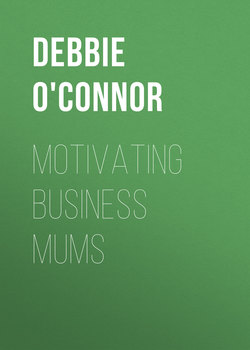Читать книгу Motivating Business Mums - Debbie O'Connor - Страница 6
На сайте Литреса книга снята с продажи.
Оглавление60-Second Networking Introductions
Grace Marshall
5 practical and 3 confidence tips for delivering great 60-second speeches
One thing that terrifies most of us when we start attending networking meetings is the prospect of standing up in a room full of strangers and speaking for 60 seconds about our business.
“What do I say?” we wonder. “What if I keep rambling or go off on a tangent?” “How do I keep to time? I keep running out of time!” or even “I can’t think of enough to say to fill 60 seconds!”
Here are five practical tips about what to say and how to structure your 60 seconds.
1. Start and end with your company name
People may not catch your name at the beginning. And often, it’s only when they hear about what you do, or what referrals you’re looking for, that they are prompted to write your name down. Reminding them at the end helps them to remember who you are and leaves them able to get in touch with you after the meeting.
2. Talk about what you do
Keep it brief and focused. Rather than put yourself under pressure to reel off a list, start with a broad statement, like “I’m a virtual assistant” or “I’m a photographer” and then focus on one service or one product that you provide. For example, “One thing I specialise in is wedding photography” or, “I’d like to talk to you today about my copy editing and proofreading.”
If you attend a regular networking meeting, this approach also keeps your 60 seconds fresh, holds attention and educates other members of the group on an ongoing basis, giving something different for them to be thinking about and looking out for each week or month.
3. Talk about the benefits
Make sure you talk about who your clients are and how they benefit from hiring or buying from you: “I help… to… with/by/so that….” Be sure to talk about the benefits, not just the features of your product or service. So if you offer a 24 hour turnaround as a feature, depending on your product, the benefit might be that your clients avoid missing their proposal deadline, avoid paying a fine or getting into trouble for leaving an anniversary gift till the last minute! Or if you design beautiful logos and websites, talk about the increase in visitors and paying clients who respond to a more professional or distinctive image.
4. Be specific about who you want to be referred to
“Anybody and everybody” draws a blank. You’re more likely to bring someone specific to mind if you say “someone who is expecting a baby” or “an arts student” or “an accountant”—someone that people can go away and contact, or be on the lookout for. You could even name a particular company you’re trying to get in touch with.
Don’t forget useful contacts and referral partners, too. Complementary businesses who serve the same types of clients as you can be great for mutual referrals. Someone at the meeting may not know of anyone about to get married, but they may well know of caterers, wedding planners, dressmakers, cake makers and contacts with venues.
5. Have a call to action
Do you want a potential client to ring you, visit your website, have a card or sign up for your free newsletter? Or do you want permission to call them? If you tell your networking partners what to say once they have spotted a potential referral, this makes it a lot easier for them to refer more business to you.
And here are three tips to boost your confidence with a 60-second networking introduction:
1. Be yourself
You don’t have to be a comedian, a silver-tongued salesman, a natural speaker or incredibly outgoing to deliver an effective 60-second introduction. And it’s okay to be nervous! Networking is about developing relationships, and people connect much more naturally when you are honest, authentic and willing to communicate. So smile, be human and be friendly whether you’re delivering or listening to a 60-second speech.
2. Be prepared
Seasoned networkers may look like they make it up as they go along, and get it right effortlessly, but there’s often more practice and preparation that goes on behind the scenes. If it helps your nerves, don’t be afraid to write yourself a script, practise it beforehand so you feel confident and comfortable with the timing, and even use it in the meeting itself if it helps you. Reading from a script may mean you’re not maintaining eye contact with your audience, but it will help you to deliver your message with clarity and confidence.
Preparation is especially key for introverts, who often communicate better when they’ve had the chance to think through and prepare what they want to say. For example, when the senior minister at our church preaches, he seems so confident and conversational that you wonder if he just makes it up on the spot. Truth is he prepares and practises A LOT, and yes, he’s an introvert too.
3. Be creative
You don’t have to be a performer to deliver a great 60-second speech. You can be creative in finding other ways of communicating. With pictures, videos or samples of your work, for example. Or even a client’s testimonial.
Grace Marshall is mum to two young children, and a life and business coach who loves to help other mums create their own definition of motherhood and business. You can get her free report: ‘YES YOU CAN! Top Ten Ways to Grow a Successful Business without Compromising Your Family’, at www.Grace-Marshall.com/YesYouCan
